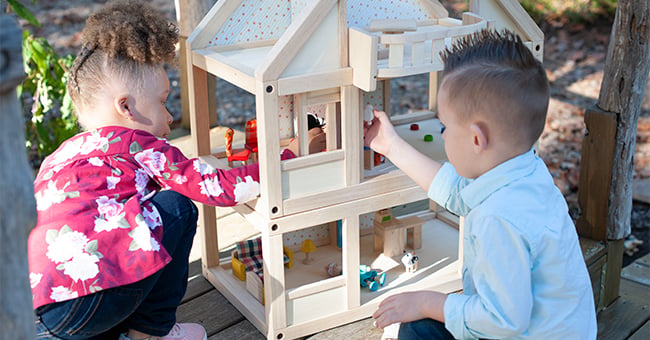
In this new blog series, Nurture in Nature, Dr. Rachel A. Larimore provides practical advice for taking the idea of creating outdoor learning spaces from scary to simple.
It seems everywhere you turn these days there is talk of outdoor learning–particularly in light of COVID-19. There is good reason for this! We know that not only is time in nature good for children's physical health, it's also beneficial for their cognitive and social-emotional health. Yet, even when we know time outdoors is good for children it can be a daunting task. This is especially true shifting from minimal time outdoors to using nature as the core to the teaching and learning, or what is called "nature-based learning." The good news is small changes can make a big difference.
Some simple shifts toward more outdoor learning related to how we structure the day, prepare the physical environment, or interact with children will get you started with nature-based learning.
Structure the day to allow for more outdoor time
First, at the core of nature-based learning is extensive time outdoors. One way to ensure more time outdoors is to start the day outside rather than to end the day there. This allows for flexibility to spend more time outdoors if the children are engaged with play. (Whereas at the end of the day, time is limited with dismissal.)
Another way to increase outdoor time is, on days where the weather is pleasant, have snacks, meals, and/or rest time outdoors. On the days when it's sunny and warm outside, you might even consider spending the entire day outside!
Once time outdoors has become part of the routine, a next step is to spend time outdoors every day unless it is dangerous to do so. This means time outdoors even on the cold and/or rainy days. To do this, children will of course need the right clothing to stay warm and dry, but I assure you it is worth the effort. There's nothing quite like seeing the joy on a young child's face as they dance in the rain and jump in puddles!
Create a physical environment rich with connections to nature
Another way to get started with nature-based learning is to create a learning environment that connects to the natural world. This can be done both outdoors and indoors.
Occasionally, I'll hear from a teacher that the children seem bored when they spend more time outdoors. In almost every case the solution is simple–more loose parts to allow for longer, more imaginative play. Loose parts are any material, manufactured or natural, that is open-ended so children can use it for multiple purposes in their play. For example, buckets, shovels, sticks, and pinecones. Loose parts can also be incorporated indoors and be used for sorting, making patterns, creating art projects, and so forth.
It's also important to consider connections to nature when selecting manufactured materials. Does the item represent authentic, local nature? Will it facilitate exploration of the outdoors?
When creating a learning environment, materials can also help blur the lines between the indoors and the outdoors. This can be as simple as windows to the outdoors, but could go further with bird feeders outside the window that children can observe when they're indoors.
Connect the learning between the indoors and the outdoors
A third way to get started with nature-based learning is to connect the experiences children are having outdoors and indoors. For example, if they've been playing with the worms on the sidewalks when it rains outside, you could read a story about worms when you're back inside. Or maybe it's fall and the children have been collecting different colored leaves on the ground. Indoors you could encourage them to create a collage using the leaves.
The key here is that teacher-led activities intentionally connect to the children's interests and the experiences they've been having outdoors. By doing this we're blurring the lines between the indoors and the outdoors and helping children to see we're part of the natural world rather than separate from it–a foundational principle in nature-based education.
By connecting the learning across spaces, creating a learning environment that connects to nature, and spending more time outdoors, you will be well on your way to implementing nature-based learning. Further, these small shifts will likely inspire both you and the children to spend even more time exploring and discovering the wonders of the natural world. Keep changing lives!
About the Author
Rachel A. Larimore, Ph.D., is an educator, speaker, consultant, and author. Her work focuses on the intentional integration of nature into early childhood education so young children learn with nature to expand their worlds and live rich, full lives. She has written three books including Establishing a Nature-Based Preschool and Preschool Beyond Walls: Blending Early Childhood Education and Nature-Based Learning. Rachel is the founder and Chief Visionary of Samara Early Learning, an organization focused on helping early childhood educators start nature-based schools or nature-based approaches into their existing programs. Prior to Samara, she worked for 11 years as the founding director of a nature-based preschool in mid-Michigan.
Explore This Series
Nurture in Nature: Supporting Equity in Outdoor Play
Nurture in Nature: Supporting School Readiness Through Outdoor Play
Nurture in Nature: Back-to-School Tips for Outdoor Play
